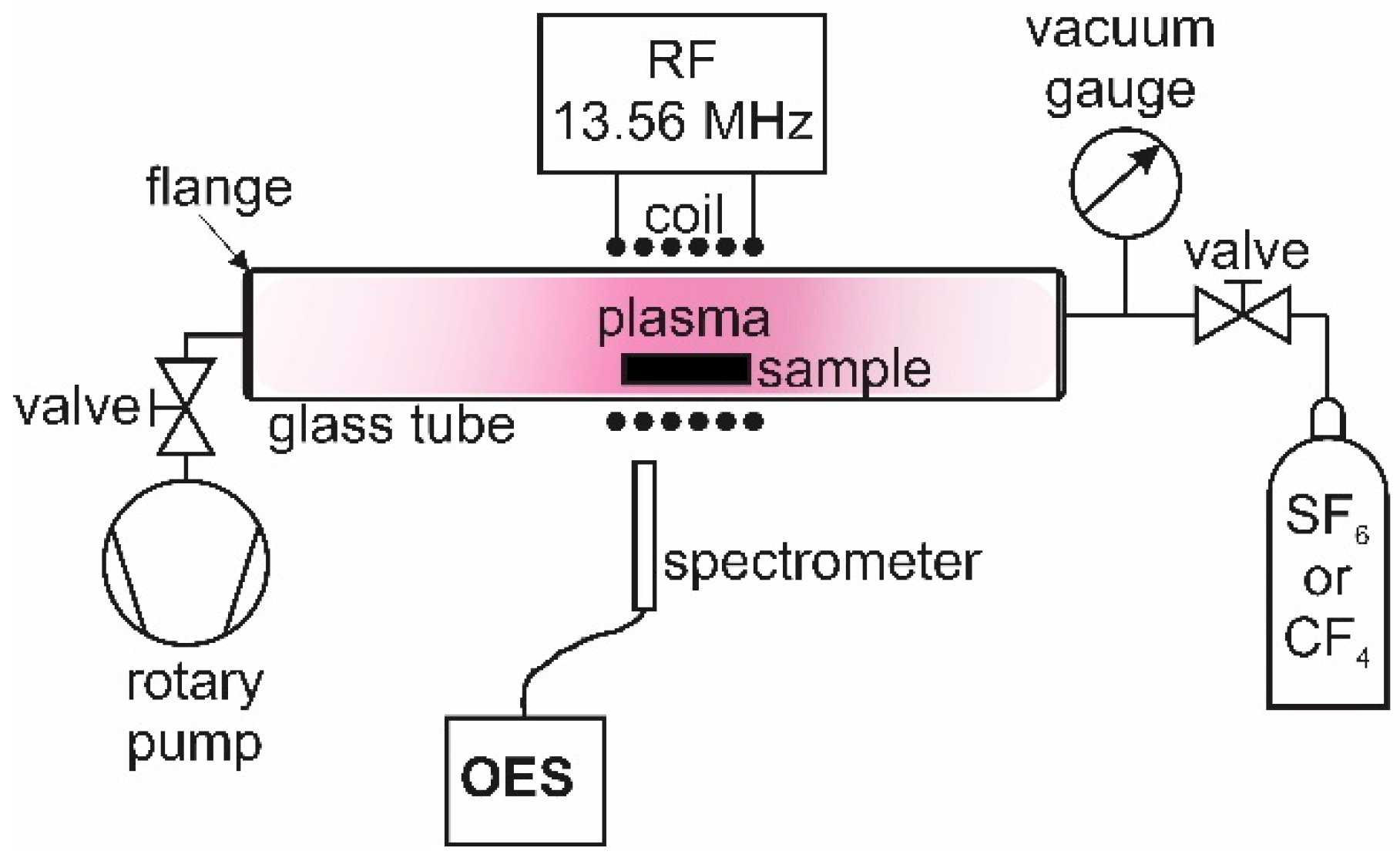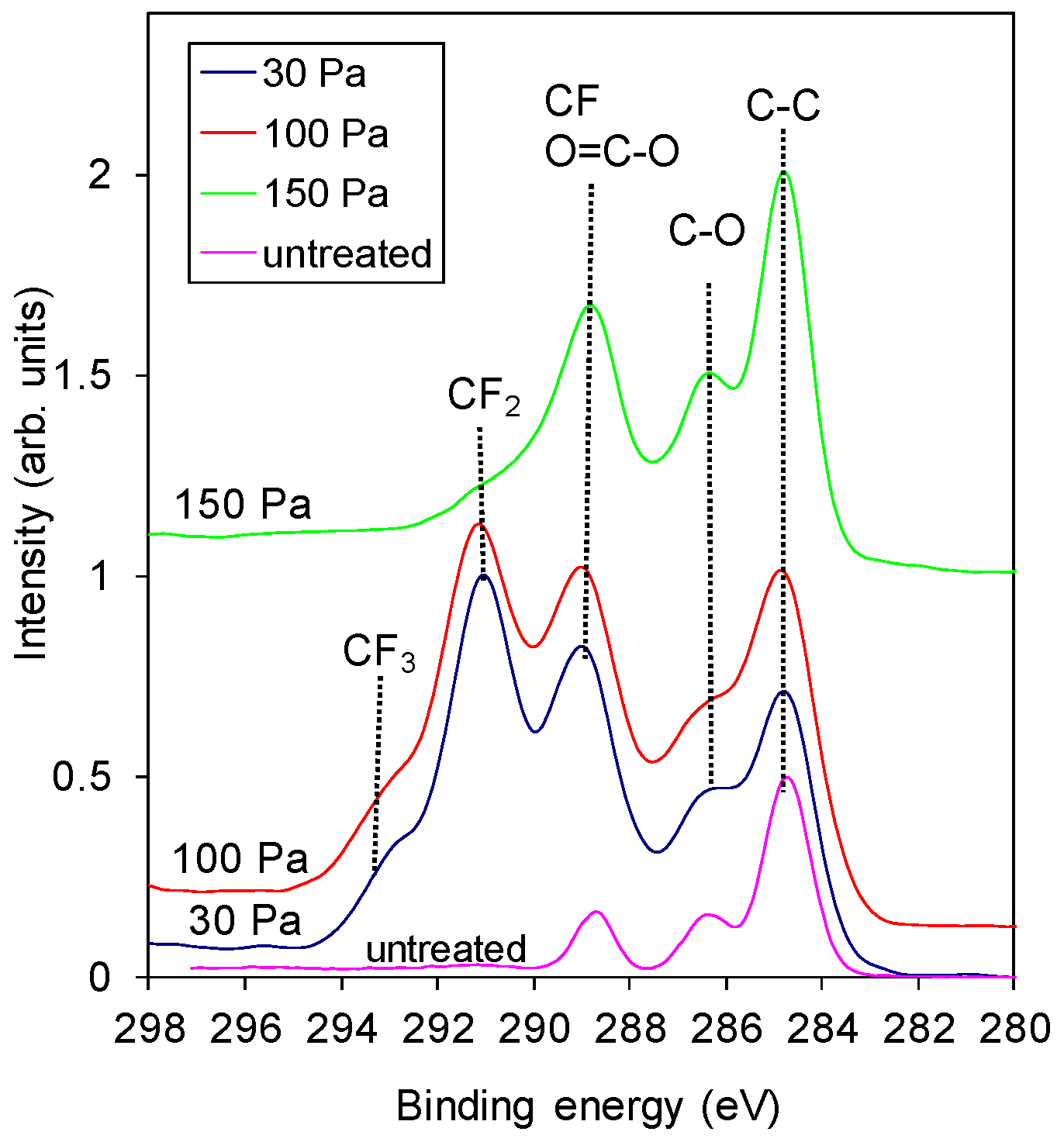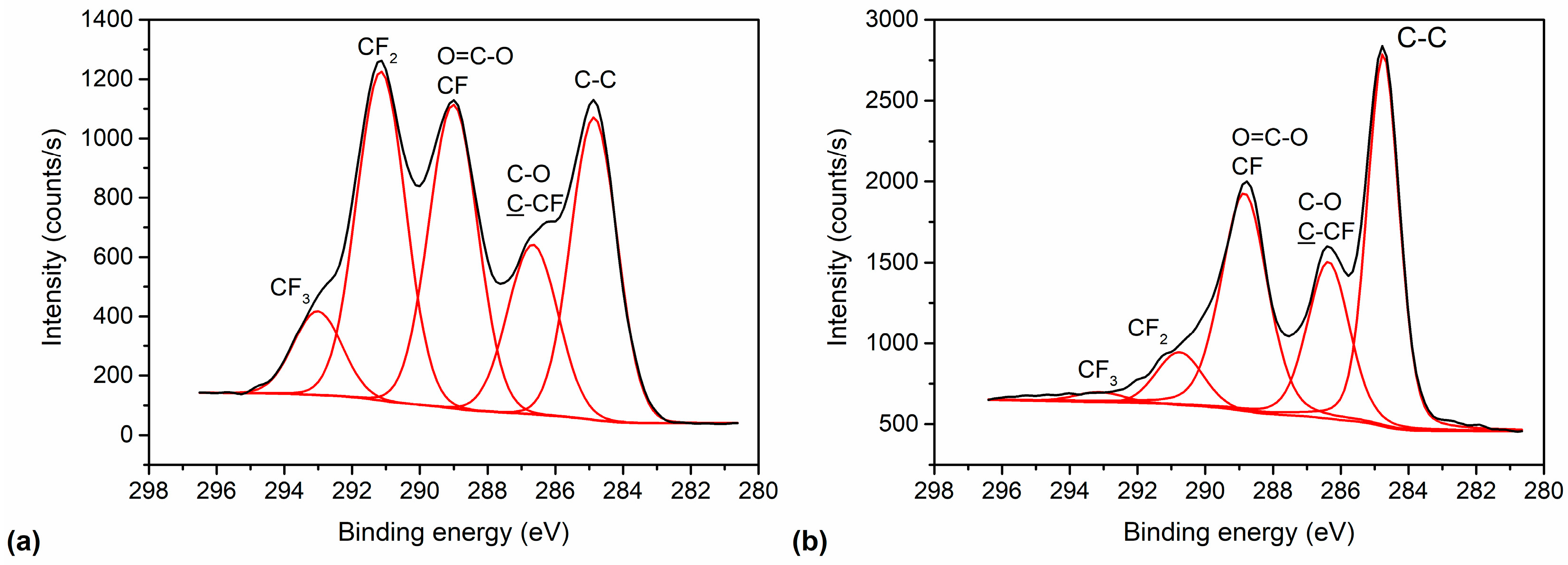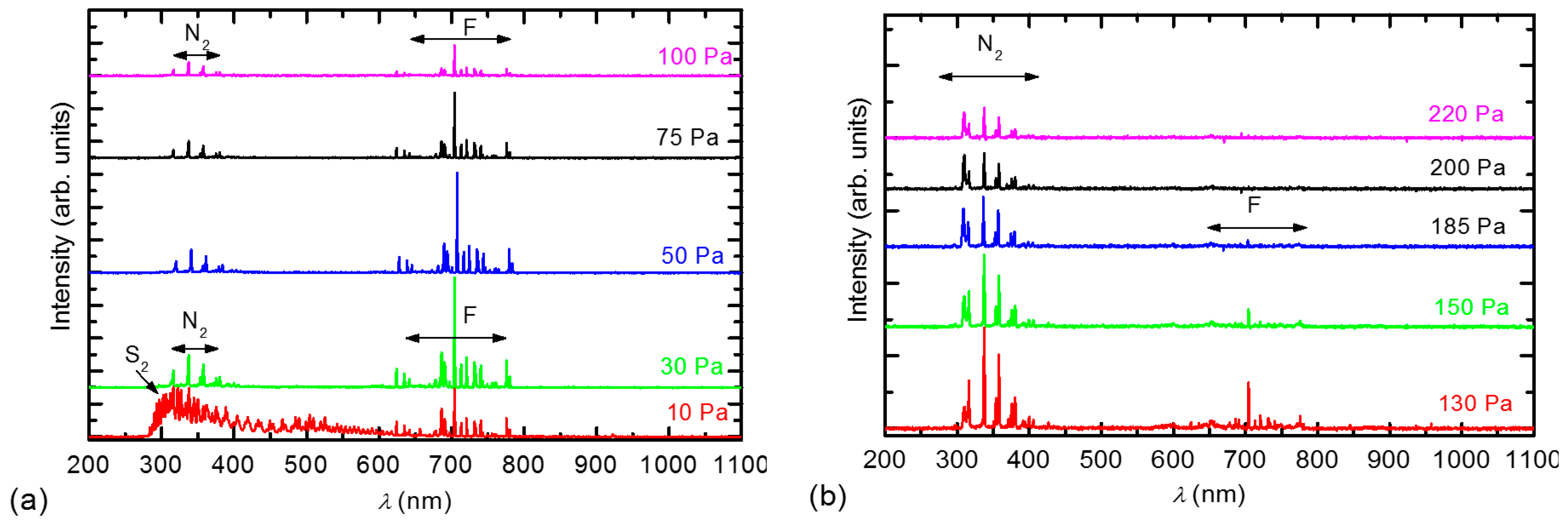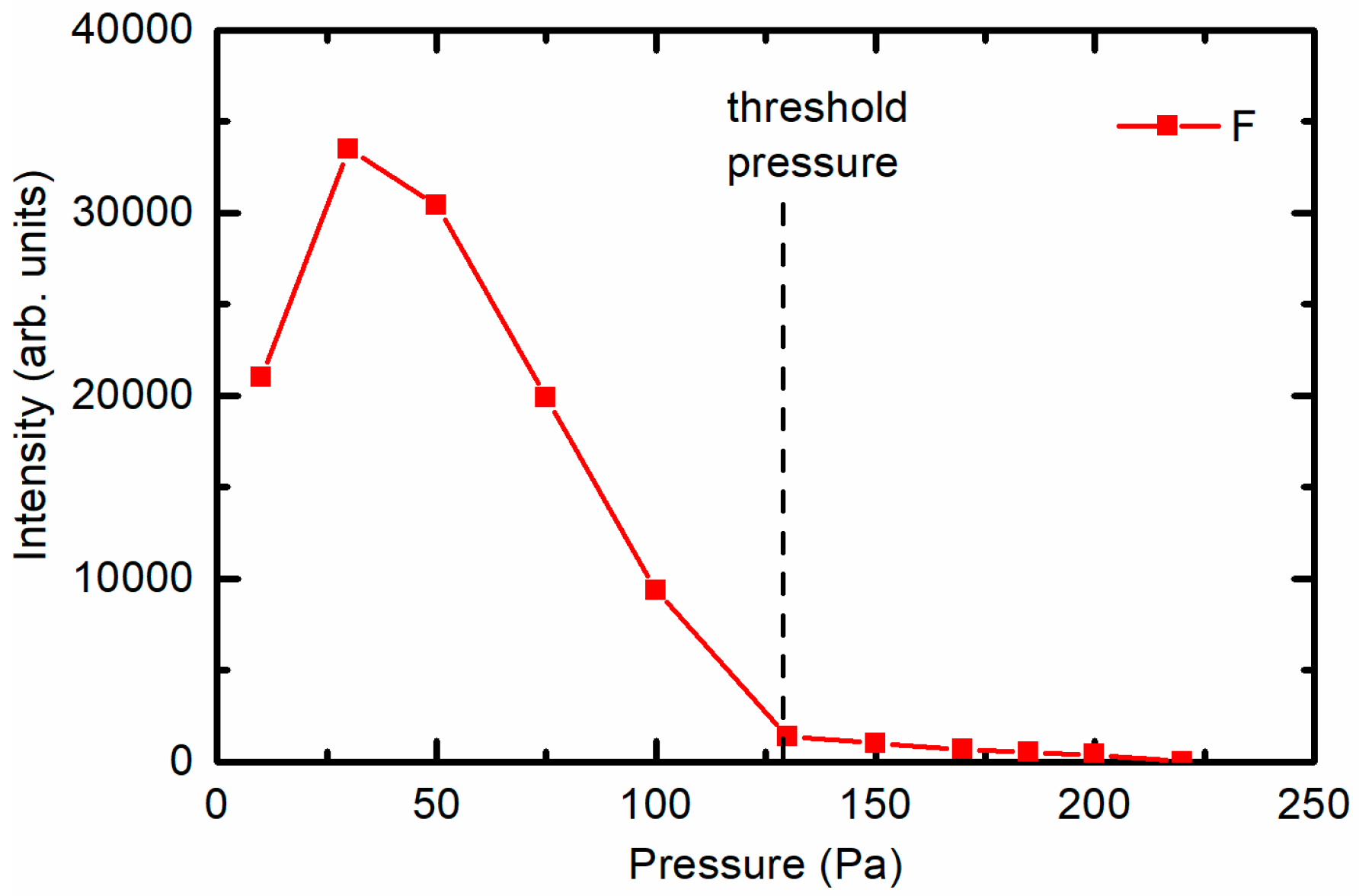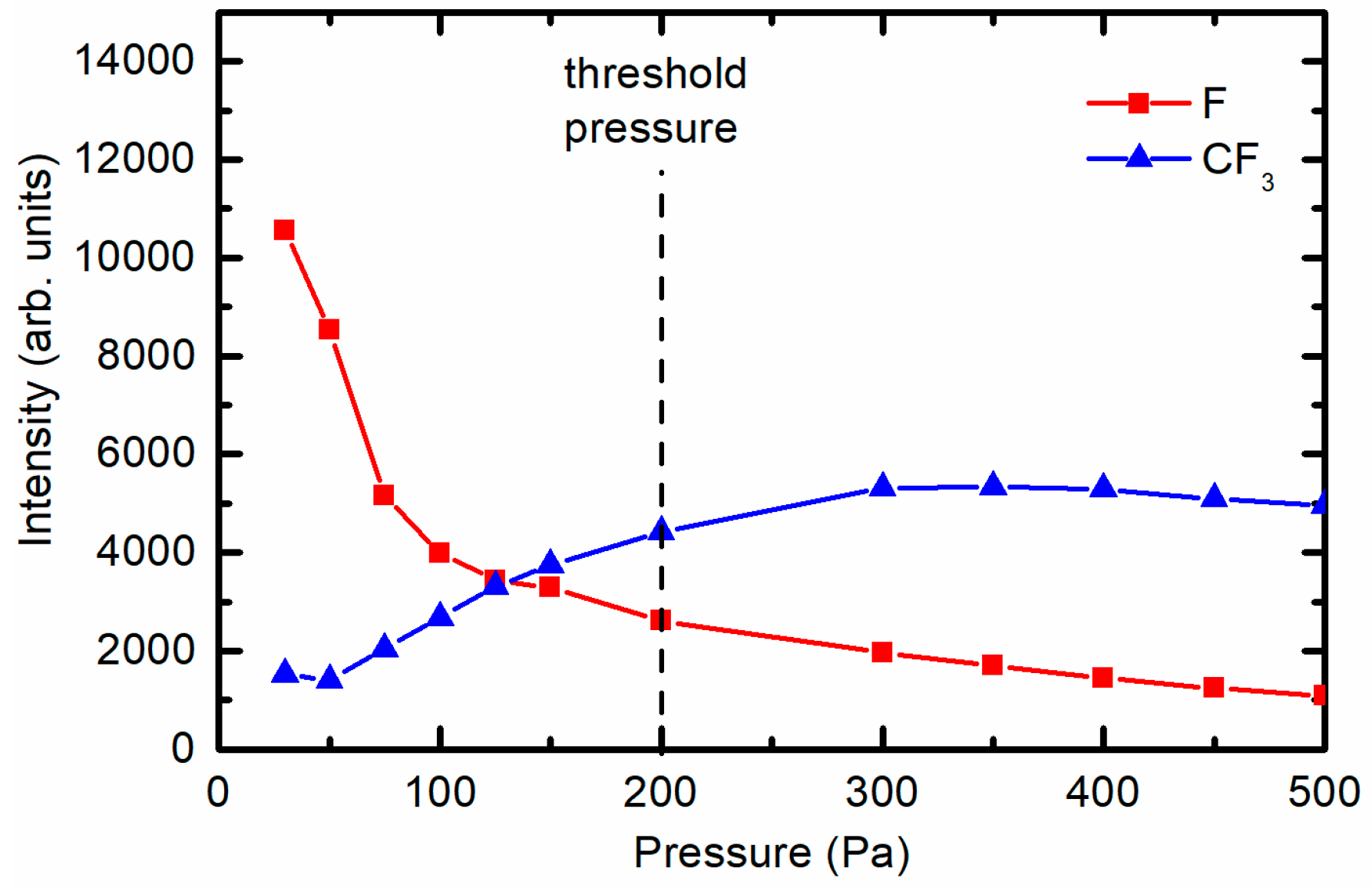1. Introduction
Fluorine-containing plasmas are often used for the surface hydrophobization of polymer materials [
1,
2,
3,
4,
5,
6,
7,
8] and for dry-etching in the semiconducting industry [
9,
10,
11,
12]. In the latter, the addition of oxygen is used to enhance the etching rate [
11]. If no oxygen is added, etching of the surface could be done by using substrate biasing. However, high ion energies can cause sample graphitization [
10]. When fluorine plasmas are used to enhance the surface hydrophobicity, two effects can be obtained, namely, functionalization or deposition (polymerization of fluorocarbons), depending on the F/C ratio [
13,
14]. If the F/C ratio is high (F/C > 3), there is no polymerization, whereas if the F/C ratio is low (F/C ≤ 2), fluorocarbons will polymerize on the surface. Thus, gases such as CF
4, SF
6 and C
2F
6 do not cause polymerization [
14,
15] unless CH
4 is added to change the F/C ratio [
16]. CF
4 is therefore often used for polymer surface modification to introduce nonpolar functional groups. SF
6 is rarely used, and therefore, literature is scarce. SF
6 plasma has been used to treat polyethylene terephthalate PET (fabric [
1], fibres [
7] or film [
5]), cotton fibres [
7], polypropylene (PP) [
3,
4], polyethylene (PE) [
5], polyvinyl chloride (PVC) [
5] and polymethyl methacrylate [
2]. The authors reported increased hydrophobicity; however, different authors reported different stabilities of the hydrophobic surface. Selli et al. found that repeated SF
6 treatment caused more stable hydrophobicity [
7]. Walton et al. found a negligible ageing effect after one year for the sample treated for the longest treatment time of 60 s, but this was not the case for the samples treated for shorter times [
6]. Mrad et al. observed the ageing of PET, whereas PVC was stable even 210 days after treatment [
5]. Polyethylene was quite stable as well, because the contact angle did not change in the first 40 days of ageing, whereas later it slightly decreased. Here, it is worth mentioning that all authors observed fluorine at the surface treated in SF
6 plasma; however, few authors observed sulphur because of grafting of SF
x species on the treated surface, which were very sensitive to ablation [
8,
17].
There have also been some reports in the literature on using O
2 plasma followed by SF
6. Mangindaan et al. prepared gradient PP surfaces with wettability between 20° and 135° by applying an O
2 pretreatment followed by SF
6 plasma treatment under a specially designed mask with an open end and a closed end, which allowed the diffusion of reactive fluorine species [
3,
4]. The highest fluorine content of 44 at % was found at the open end, and only 3 at % was found at the close end of the mask. In contrast, the oxygen concentration was approximately 11 and 30 at % at the open and closed ends, respectively. The sulphur content was very small at approximately 0.4 at %. The authors also studied the adhesion of fibroblast cells and found that the number of cells decreased from the hydrophobic surface at the open end to the hydrophilic surface at the closed end. Consecutive O
2 and SF
6 plasma treatments were also applied by Bi et al. for treatment of Parylene-C to obtain a superhydrophobic surface [
18]. Oxygen plasma treatment time was varied, whereas the treatment time in the SF
6 plasma was kept constant. The hydrophobicity increased with increasing pretreatment time in the O
2 plasma until saturation was achieved with a contact angle of 169°. The obtained superhydrophobic surface was a result of the increased surface nanoroughness induced by O
2 plasma treatment, followed by surface fluorination with SF
6 plasma treatment.
In this paper, we investigated and compared the SF6 and CF4 plasma created at various pressures on the surface modification of PET polymer films.
3. Results and Discussion
Figure 2a shows the variation of the XPS surface composition of the PET polymer treated in SF
6 plasma versus pressure. The values for the atomic concentration at a pressure of 0 Pa correspond to an untreated sample. The measured values for the untreated sample, i.e., 25 at % oxygen and 75 at % carbon, are close to the theoretical values for pure polyethylene terephthalate. These values are altered upon plasma treatment, as demonstrated in
Figure 2a.
As expected, fluorine appeared on the surface, and its concentration was dependent upon the pressure in the discharge chamber during the plasma treatment of the polymer sample. Two regions can be distinguished. The first one appeared at pressures up to approximately 130 Pa, where the surface composition was relatively constant and was independent of the pressure. However, at pressures higher than 130 Pa, a drastic (and rather abrupt) modification of the surface composition occurred. Hereinafter, a pressure of 130 Pa is considered the threshold pressure. In the first region, below the threshold pressure, plasma treatment resulted in intensive fluorination of the polymer because a high fluorine content of approximately 46 at % was found. Furthermore, the oxygen concentration decreased from the initial 26 to 10 at %. In the second region, above the threshold pressure, the fluorine concentration on the polymer surface dropped to only ~ 16 at %, whereas the oxygen concentration increased to almost 30 at %. Another important difference in both regions was the presence of a minor concentration of other elements. In addition to carbon and oxygen, which were already present in the original polymer, only fluorine was found in the first region. However, in the second region, a minor concentration of sulphur from SF
x radicals was found as well (<1 at %). A detailed reason for this transition will be explained later in the text. It is correlated with the concentration of F atoms in the plasma, which was lower after the threshold pressure; therefore, surface fluorination was less efficient. Furthermore, all vacuum systems contain water vapour, which dissociates to O and OH radicals that compete with F atoms and cause oxidation. For this reason, a higher oxygen concentration was found above the threshold pressure. This phenomenon, whereby oxidation may occur when treating materials in F-containing plasmas, has been observed before and was published in [
19].
The significant change in the surface concentration of F and O before and after the threshold pressure is also observed in the high-resolution carbon C 1s spectra shown in
Figure 3. The samples treated at pressures below the threshold pressure were rich in CF
3 and CF
2 as well as CF functional groups (see
Figure 4 also), whereas the sample treated at pressures higher than the threshold pressure had only some CF groups and an insignificant number of CF
2 functional groups in the surface film probed by the photoelectrons. This result is shown in more detail in
Figure 4, where an example of a detailed curve deconvolution of the C 1s spectra showing peak assignment is presented. The C 1s peak was fitted with five components positioned at the binding energies of 284.8 eV assigned to C–C, 286.5 eV assigned to C–O and
C–CF, 289 eV assigned to O–C=O and CF, 291.3 eV to CF
2 and 293 eV to CF
3 [
20,
21].
When treating the polymer in CF
4 plasma (
Figure 2b), a similar behaviour was observed as when treated in SF
6 plasma. However, the transition between the regions of high and low fluorine content was not very sharp (it appeared approximately at a threshold pressure of 200 Pa) and was less intense (the fluorine concentration dropped to only 30 at %, and oxygen increased to almost 23 at %). In the first region below the threshold pressure, there was no significant difference in the fluorine concentration on the sample treated in CF
4 or SF
6 plasma, (
Figure 2a,b, respectively).
Figure 5 shows a comparison of selected carbon peaks for the samples treated in CF
4 and SF
6 plasma at 100 Pa (low-pressure region). We see only minor differences in the intensity of the various fluorine functional groups of CF, CF
2, and CF
3 and the presence of OCF
3 at ~295 eV for the sample treated in CF
4 plasma.
Plasma treatment changed the surface hydrophobicity of the samples. The water contact angle increased from the initial 76° to approximately 106° regardless of using the CF
4 or SF
6 plasma as long as the pressure was low enough (below the threshold). The value of 106° is typical for hydrophobic materials with a smooth surface [
22]. The variation of the contact angle with pressure is interesting, as shown in
Figure 6a. We can see that after the threshold pressure, when a decrease in fluorine and an increase in the oxygen concentration were observed (
Figure 2a), the water contact angle significantly decreased to approximately 35°. The surface lost its hydrophobic character and became hydrophilic because of a lack of nonpolar fluorine functional groups and the presence of more polar oxygen groups. Interestingly, the water contact angle for PET treated at high pressure in SF
6 plasma was much lower than that for the untreated polymer, which was 76°. Measurements of the surface roughness by AFM showed only a slight increase in the roughness from 1.2 nm measured for the untreated sample to 2.3 and 2.6 nm measured for the samples treated in SF
6 and CF
4 plasma, respectively. Therefore, only a minor influence of the surface roughness on the contact angles was observed, and the major reason for modified wettability is thus chemical modification of the surface.
Figure 6b also shows the results for the CF
4 plasma. Similar to the results obtained for SF
6 plasma treatment, we observed that, after the threshold pressure, the contact angle decreased. However, the decrease was less pronounced, which is correlated with a lower oxygen content in comparison to the sample treated in SF
6 plasma (
Figure 2).
To explain such unusual behaviour of the surface composition and surface wettability with the pressure, we performed OES characterization of the plasma. OES spectra are shown in
Figure 7.
Figure 7a shows the spectra measured at low pressures (before the threshold pressure), while
Figure 7b shows the spectra measured above the threshold pressure.
At low pressures, intensive atomic F lines in addition to bands corresponding to the N
2 molecule are observed (
Figure 7a). One exception is the spectrum measured at the lowest pressure 10 Pa, where bands corresponding to the S
2 molecule are observed as well. The appearance of the S
2 molecules can only be explained by the almost full dissociation of SF
6 and the subsequent recombination to sulphur dimers. The presence of nitrogen, which is known to be a strong emitter, was explained as an impurity present in the original gas according to the manufacturer’s specifications. At high pressures (
Figure 7b), the situation was different because the intensity of the F lines decreased. The variation in the F emission intensity with pressure is plotted in
Figure 8.
Figure 8 is in excellent agreement with
Figure 2; at low pressures, where the emission intensity of F is high, the concentration of fluorine on the polymer surface is high. Whereas at higher pressures, when the OES intensity of F decreased, the XPS concentration of fluorine decreased.
This phenomenon deserves further discussion. In SF
6 plasma, SF
x dissociates according to [
23,
24]:
The extent of dissociation and thus the concentration of radicals such as SF
5, SF
4, SF
3, SF
2, SF, S and F depends on the electron density and temperature, which in turn depends on the pressure. According to Kokkoris et al., a loss of SF
x and F species on the reactor walls is also important for the production and consumption of neutral plasma species [
23]. The F atoms tend to associate with F
2 molecules either by heterogeneous surface recombination or in the gas-phase—the probability of gas-phase loss increases as a square of the pressure, because three-body collisions are necessary.
SF
6 gas is also known to be a highly electronegative gas, which means that it has a strong tendency to acquire free electrons, thus forming negative ions:
[
24,
25]. At low pressures, the electron temperature is high, thus causing a strong dissociation of SF
6 and, thus, the occurrence of a high density of F atoms in the plasma. The F atoms diffuse and eventually reach the polymer surface where they interact chemically and cause at least partial substitution of oxygen in the surface film of the PET polymer. The exact interaction mechanism is still unknown, but a high fluence of F atoms onto the surface of the polymer will guarantee the substitution of almost all oxygen in the PET surface by fluorine. The curves in
Figure 3 obtained at 30 and 100 Pa confirm this simplified explanation.
At high pressures, however, the electron density and temperature decrease; therefore, the dissociation of SF
6, which has a relatively high dissociation energy of
WD = 9.6 eV, is less effective [
24]. Furthermore, the loss of F atoms due to the gas phase reactions becomes important. Electrons are also lost by the attachment to SF
6 molecules. The lack of electrons capable of SF
6 dissociation caused the density of the fluorine atoms in the plasma to decrease significantly at elevated pressure.
Similar conclusions can be drawn for SF
6 plasma as for CF
4 plasma. However, CF
4 is as strongly electronegative as SF
6; therefore, this effect is not very pronounced. For the CF
4 plasma, F atomic lines are observed in the OES spectra at low pressures up to the threshold pressure (
Figure 9a). The CF
3 continuum is not observed below the threshold pressure (200 Pa), where it is barely noticeable.
Therefore, we can expect good dissociation of CF
4 at low pressures according to [
26]:
The intensity of the F line decreased with increasing pressure. Furthermore, a continuum corresponding to CF
3 appeared at high pressures (
Figure 9b). The appearance of the CF
3 continuum coincided with a decrease in the F intensity.
Figure 10 represents the radiation intensity arising from the F atoms and the CF
3 radicals. At elevated pressure, the radiation from the F-atoms became marginal, indicating qualitatively that the dissociation of multiple CF
4 molecules was scarce. Comparing
Figure 2 and
Figure 10, we can again conclude that at high pressures, the electron temperature and density was so low that it was insufficient to cause substantial dissociation of CF
4, and thus, the substitution of oxygen with fluorine on the PET polymer upon plasma treatment was poor.
